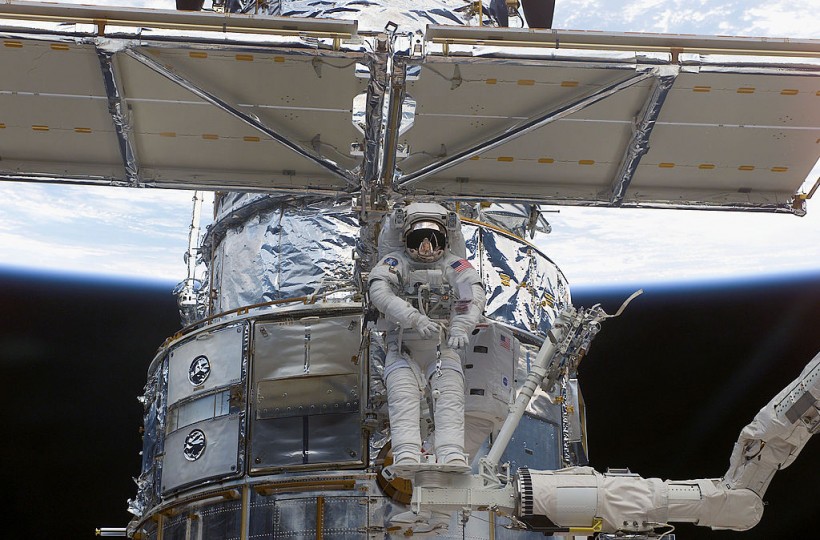NASA's Hubble Space Telescope has temporarily halted its science operations due to an ongoing gyroscope issue that prompted the telescope to enter safe mode on November 23.
While in safe mode, Hubble's instruments remain stable, and the telescope is in good health, but science operations are suspended until the issue is resolved.

IN SPACE - MARCH 4: (FILE PHOTO) In this image released by the National Aeronautics and Space Administration (NASA), astronaut Richard M. Linnehan works to replace the starboard solar array on the Hubble Space Telescope (HST) during an extravehicular activity (EVA) to try and upgrade some components of the telescope March 4, 2002 in space. NASA plans to replace the Hubble telescope with the new James Webb Space Telescope (JWST) and plans to deorbit the Hubble telescope sometime in 2010.
NASA: Why Hubble Had to Pause
According to NASA, the gyroscope problem arose when one of Hubble's three gyroscopes provided faulty readings, causing the telescope to enter safe mode automatically. Gyroscopes are crucial components that measure the telescope's turn rates and help determine its pointing direction.
Although the telescope successfully recovered from a previous safe mode on November 19, the unstable gyro led to another suspension of science operations on November 21.
After a subsequent recovery, Hubble entered safe mode again on November 23. NASA's operations team is actively assessing the gyro issue and developing potential solutions.
If required, adjustments can be made to the spacecraft's configuration, allowing it to function with only one gyro out of the six installed during the last space shuttle servicing mission in 2009. Currently, three gyros are in operational condition, though one is exhibiting fluctuations.
"NASA anticipates Hubble will continue making groundbreaking discoveries, working with other observatories, such as the agency's James Webb Space Telescope, throughout this decade and possibly into the next," the space agency said in a statement.
Read Also: NASA Hubble Discovers Saturn's Ring System Heats Planet's Atmosphere-A Never-Before-Seen Phenomenon!
NASA's Hubble Space Telescope Sees an 'Evil Eye'
In another celestial view captured by Hubble, a visually stunning galaxy resembling an "evil eye" has been documented 17 million light-years away in the constellation Coma Berenices. Known as Messier 64 (M64) or the "Black Eye" galaxy, it displays distinctive bands of cosmic dust resulting from the collision of two galaxies.
The captivating image showcases a luminous yellow nucleus surrounded by dark dust in various shades of brown and orange, with swirling blue and purple dots near the galaxy's center. Messier 64 has intrigued astronomers since its discovery in 1799 due to its unique internal dynamics, likely influenced by a recent galaxy merger.
The Hubble Space Telescope unveils this galaxy's intricate details, particularly the dark band of absorbing dust in its central region. Despite the temporary interruption in its science mission, Hubble continues to provide breathtaking views of the cosmos, contributing to our understanding of the universe.
Related Article: NASA's Hubble Space Telescope Captures 'Butterfly Nebula' In Stunning Motion | Fun Facts About This Beautiful Space Butterfly










